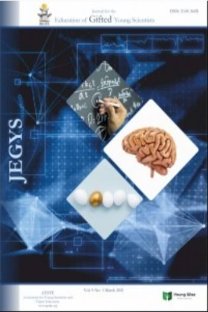A Study Related to the Investigation of Multiple Intelligence Profiles of Gifted and Talented Children across Turkey
Focusing on the dominant intelligences of individuals from their early ages will be beneficial for them and the society in terms of improving their talents. When this situation is considered for gifted and talented children, we believe that there is a need for detailed analysis for Turkey beginning from the early years of children. Hence, in this study, it is aimed to investigate the multiple intelligence domains of Turkish gifted and talented students studying in science and art centres (SACs) across the country via a survey research. This paper presents the results gained from 12 SACs. Those SACs were selected according to the socio-economic development index (SEDI) of Turkey as declared by Ministry of Development (MD) which considered the country to consist of 6 regions. Two SACs from each of those six regions were included in the study. Thus, the sample consisted of 390 middle school 5th grade students. A Likert type multiple intelligence test which included 80 items related to eight domains of multiple intelligence was utilized as data collection instrument (Demirel, Başbay & Erdem, 2006: 155). Descriptive statistics and non-parametric statistics tests were conducted in order to analyze the study data. The results indicated various differences among multiple intelligence scores of the participants.
___
- Barrington, E. (2004) Teaching to student diversity in higher education: how multiple intelligence theory can help. Teaching in Higher Education, 9(4), 421-434.
- Baykoç, N. (2011). Üstün ve özel yetenekli çocuklar ve eğitimleri [Gifted and special talented children and their education]. In N. Baykoç [Ed.] (2011). Özel gereksinimli çocuklar ve özel eğitim [Children with special needs and special education]. Ankara: Eğiten Kitap, pp. 367.
- Bulut, İ. (2010). Türkiye'de üstün zekâlı çocuklar örneğinde erken yaşta yabancı dil olarak ingilizce öğretimi [Teaching English as a foreign language to young learners in Turkey in the case of gifted children]. Unpublished PhD Thesis, İstanbul University, İstanbul.
- Büyüköztürk, Ş. (2010). Sosyal bilimler için veri analizi el kitabı [Data analysis handbook for social sciences] (11th ed.) Ankara: PegemA, pp. 156-158.
- Büyüköztürk, Ş., Çakmak, E. K., Akgün, Ö. E., Karadeniz, Ş., & Demirel, F. (2010). Bilimsel araştırma yöntemleri [Scientific research methods] (6th ed.). Ankara: Pegem Akademi, pp. 89-231.
- Çalık, B., & Birgili, B. (2013). Multiple intelligence theory for gifted education: criticisms and implications. Journal for the Education of the Young Scientist and Giftedness, 1(2), 1-12.
- Chan, D. W. (2004) Multiple intelligences of chinese gifted students in hong kong: perspectives from students, parents, teachers, and peers. Roeper Review, 27(1), 18-24.
- Chan, D. W. (2005). Perceived multiple intelligences and learning preferences among chinese gifted students in hong kong. Journal for the Education of the Gifted, 29(2), 187–212.
- Chan, D. W. (2006). Perceived multiple intelligences among male and female chinese gifted students in hong kong: the structure of the student multiple intelligences profile. Gifted Child Quarterly, 50(4), 325-338.
- Çöllüoğlu Gülen, Ö., & Özdemir, S. (2013). Veri madenciliği teknikleri ile üstün yetenekli öğrencilerin ilgi alanlarının analizi [Analysis of gifted students’ interest areas using data mining techniques]. Journal of Gifted Education Research, 1(3), 213-226.
- Demirel, Ö., Başbay, A., & Erdem, E. (2006). Eğitimde çoklu zeka kuram ve uygulama [Theory and practice for multiple intelligences in education]. Ankara: PegemA, pp. 13-155.
- Eryiğit, D. (2014). Kitap incelemesi: Üstün Yetenekli Çocukları Anlamak: Üstün Yetenekli Çocuklar Sarmalında Aile, Eğitim Sistemi ve Toplum Yazar: Faruk LEVENT [Book review: Understanding Gifted Children: The Helical of Gifted Children in Family, Education System and Society. Author: Faruk LEVENT]. Journal of Gifted Education Research, 2(1), 88-91.
- Fasko, D. (2001) An analysis of multiple intelligences theory and its use with the gifted and talented, Roeper Review, 23(3), 126-130.
- Gardner, H. (1993). Frames of mind: The theory of multiple intelligences. New York, NY: Basic Books.
- Gardner, H. (1999). Intelligence reframed: multiple intelligence for the 21st centrury. Ny: Basic Books.
- İflazoğlu Saban, A. (2011). An evaluation of the teaching activities implemented in the elementary science and technology courses in terms of multiple intelligence theory: a sample from adana. Educational Sciences: Theory & Practice, 11(3), 1641-1649.
- Kahraman, S., & Bulut Bedük, Ş. (2014). Üstün yetenekli/zekâlı 6., 7., 8. sınıf öğrencilerinin çoklu zekâ alanlarının bazı değişkenlere göre incelenmesi [A study of multiple intelligences in 6th-7th-8th grade gifted students]. Journal of Gifted Education Research, 2(1), 58-73.
- Koura, A. A., & Al-Hebaishi, S. M. (2014). The relationship between multiple intelligences, self- efficacy and academic achievement of saudi gifted and regular intermediate students. Educational Research International, 3(1), 48-70.
- Ministry of Development. (2013). İllerin ve bölgelerin sosyo-ekonomik gelişmişlik sıralaması araştırması [The research of socio-economic development index of provinces and regions]. Retrieved October 2, 2014 from http://www.kalkinma.gov.tr/Lists/Yaynlar/Attachments/548/SEGE-2011.pdf
- Ministry of National Education. (2009). Bilim ve sanat merkezleri yönergesi [Directory for science and art centres]. Retrieved November 17, 2014 from http://mevzuat.meb.gov.tr/html/2593_0.html
- Özmen, H. (2012). Öğrenme kuramları ve fen bilimleri öğretimindeki uygulamaları [Learning theories and applications in science teaching]. In S. Çepni [Ed.] Kuramdan uygulamaya fen ve teknoloji öğretimi [Science and technology teaching from theory to practice] (10th ed.). (pp.33-98). Ankara: PegemA.
- Reid, C., & Romanoff, B. (1997). Using multiple intelligence theory to identify gifted children. Educational Leadership, September, 71-74.
- Saban, A. (2009). Content analysis of turkish studies about the multiple intelligences theory. Educational Sciences: Theory & Practice, 9(2), 859-876.
- Tuğrul, B., & Duran, E. (2003). Her çocuk başarılı olmak için bir şansa sahiptir: zekanın çok boyutluluğu çoklu zeka kuramı [Every child has a chance to be successful multi-dimention of intelligence multiple intelligence theory]. Hacettepe University Education Faculty Journal, 24, 224-233.
- Ün Açıkgöz, K. (2012). Aktif öğrenme [Active learning] (12th ed.). İzmir: Biliş, pp. 287-289.
- VanTassel-Baska, J., & Brown, E. F. (2007). Toward best practice: an analysis of the efficacy of curriculum models in gifted education. Gifted Child Quarterly, 51(4), 342-358
- Başlangıç: 2013
- Yayıncı: Genç Bilge Yayıncılık
